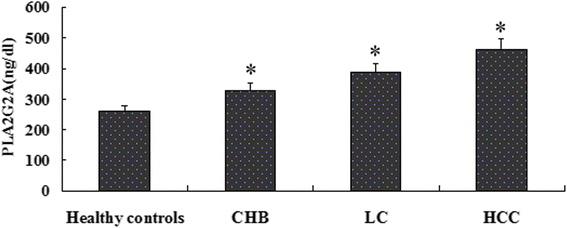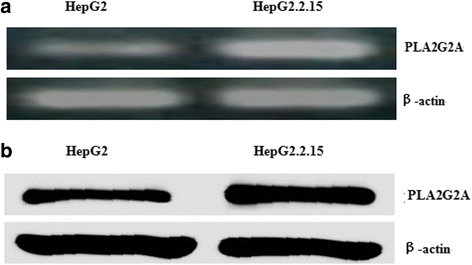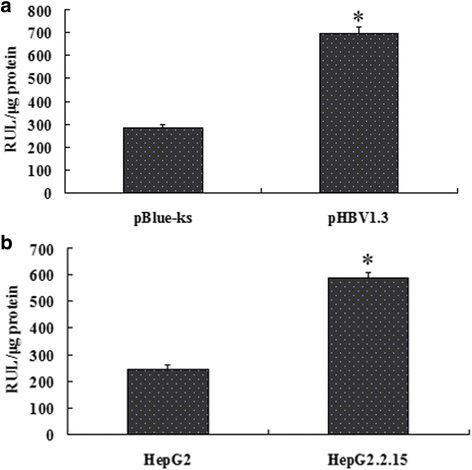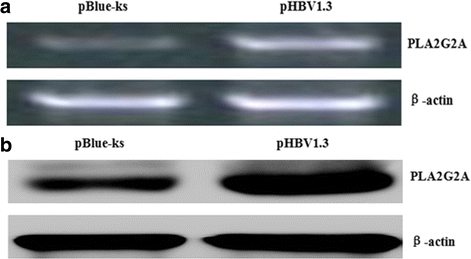Promoting effect of hepatitis B virus on the expressoin of phospholipase A2 group IIA
- PMID: 28077172
- PMCID: PMC5225502
- DOI: 10.1186/s12944-016-0400-7
Promoting effect of hepatitis B virus on the expressoin of phospholipase A2 group IIA
Abstract
Background: Hepatitis B virus (HBV) infection causes acute and chronic liver disease, ultimately leading to the development of liver cirrhosis (LC) and hepatocellular carcinoma (HCC). Phospholipase A2 group IIA (PLA2G2A) plays important roles in the development and progression of many tumors. Thus far, there have been no reports on the association between HBV and PLA2G2A. The present study investigated the effect of HBV infection on PLA2G2A expression and its application in the diagnosis of HBV-related diseases.
Methods: Serum levels of PLA2G2A in 308 HBV-infected patients and 185 healthy controls were measured using an enzyme-linked immunosorbent assay (ELISA). The difference in serum levels of PLA2G2A was analyzed among chronic hepatitis B (CHB), LC, and HCC patients. PLA2G2A mRNA and protein expression in HepG2 and HepG2.2.15 cells carrying the integrated HBV genome were measured using reverse transcription polymerase chain reaction (RT-PCR) and western blot assays. The HBV infectious clone pHBV1.3, the control plasmid pBlue-ks and PLA2G2A gene promoter were transfected into HepG2 and HepG2.2.15 cells. After transfection, the luciferase activity was measured in the cells. PLA2G2A mRNA and protein expression levels were examined using RT-PCR and western blot assays.
Results: The serum levels of PLA2G2A were 258.3 ± 20.3ng/dl in the healthy controls and 329.0 ± 22.5ng/dl, 385.4 ± 29.3ng/dl and 459.2 ± 38.6ng/dl in the CHB, LC, and HCC patients, respectively. Statistical analyses revealed significantly higher serum levels of PLA2G2A in CHB, LC, and HCC patients than in the healthy controls (P < 0.05), and PLA2G2A levels were elevated in the order of HCC > LC > CHB group. High serum PLA2G2A levels in HCC patients were associated with a lower prevalence of lymph node metastasis and a lower TNM stage. HepG2.2.15 cells carrying the HBV genome expressed higher levels of PLA2G2A mRNA and protein than the HepG2 cells. In addition, HBV triggered PLA2G2A promoter activity and enhanced PLA2G2A mRNA and protein expression compared to the empty vector pBlue-ks.
Conclusion: HBV can upregulate the expression of PLA2G2A, and serum levels of PLA2G2A are associated with the progression of HBV-related diseases.
Keywords: Chronic hepatitis B; Hepatitis B virus; Hepatocellular carcinoma; Liver cirrhosis; Phospholipase A2 group IIA.
Figures




Similar articles
-
The mechanism of apoliprotein A1 down-regulated by Hepatitis B virus.Lipids Health Dis. 2016 Mar 25;15:64. doi: 10.1186/s12944-016-0232-5. Lipids Health Dis. 2016. PMID: 27015844 Free PMC article.
-
Association of PD-L1 gene polymorphisms and circulating sPD-L1 levels with HBV infection susceptibility and related liver disease progression.Gene. 2022 Jan 5;806:145935. doi: 10.1016/j.gene.2021.145935. Epub 2021 Aug 31. Gene. 2022. PMID: 34478821
-
Exportin 4 gene expression and DNA promoter methylation status in chronic hepatitis B virus infection.J Viral Hepat. 2014 Apr;21(4):241-50. doi: 10.1111/jvh.12136. Epub 2013 Jul 24. J Viral Hepat. 2014. PMID: 24597692
-
Associations between activation-induced cytidine deaminase/apolipoprotein B mRNA editing enzyme, catalytic polypeptide-like cytidine deaminase expression, hepatitis B virus (HBV) replication and HBV-associated liver disease (Review).Mol Med Rep. 2015 Nov;12(5):6405-14. doi: 10.3892/mmr.2015.4312. Epub 2015 Sep 10. Mol Med Rep. 2015. PMID: 26398702 Free PMC article. Review.
-
Autophagy and microRNA in hepatitis B virus-related hepatocellular carcinoma.World J Gastroenterol. 2016 Jan 7;22(1):176-87. doi: 10.3748/wjg.v22.i1.176. World J Gastroenterol. 2016. PMID: 26755869 Free PMC article. Review.
Cited by
-
Bioinformatics analysis on multiple Gene Expression Omnibus datasets of the hepatitis B virus infection and its response to the interferon-alpha therapy.BMC Infect Dis. 2020 Jan 29;20(1):84. doi: 10.1186/s12879-019-4720-x. BMC Infect Dis. 2020. PMID: 31996147 Free PMC article.
-
Identification of an Allele-Specific Transcription Factor Binding Interaction that May Regulate PLA2G2A Gene Expression.Bioinform Biol Insights. 2024 Jul 30;18:11779322241261427. doi: 10.1177/11779322241261427. eCollection 2024. Bioinform Biol Insights. 2024. PMID: 39081667 Free PMC article.
-
Phospholipase A2 enzymes PLA2G2A and PLA2G12B as potential diagnostic and prognostic biomarkers in cholangiocarcinoma.World J Gastrointest Surg. 2024 Feb 27;16(2):289-306. doi: 10.4240/wjgs.v16.i2.289. World J Gastrointest Surg. 2024. PMID: 38463362 Free PMC article.
-
HBV Upregulates CtBP2 Expression via the X Gene.Biomed Res Int. 2018 Jul 31;2018:6960573. doi: 10.1155/2018/6960573. eCollection 2018. Biomed Res Int. 2018. PMID: 30151388 Free PMC article.
-
Phospholipase A2 Group IIA Is Associated with Inflammatory Hepatocellular Adenoma.Cancers (Basel). 2023 Dec 28;16(1):159. doi: 10.3390/cancers16010159. Cancers (Basel). 2023. PMID: 38201587 Free PMC article.
References
-
- Yamada R, Hiramatsu N, Oze T, Morishita N, Harada N, Yakushijin T, Iio S, Doi Y, Yamada A, Kaneko A, et al. Impact of alpha-fetoprotein on hepatocellular carcinoma development during entecavir treatment of chronic hepatitis B virus infection. J Gastroenterol. 2015;50:785–794. doi: 10.1007/s00535-014-1010-7. - DOI - PubMed
MeSH terms
Substances
LinkOut - more resources
Full Text Sources
Other Literature Sources
Medical

